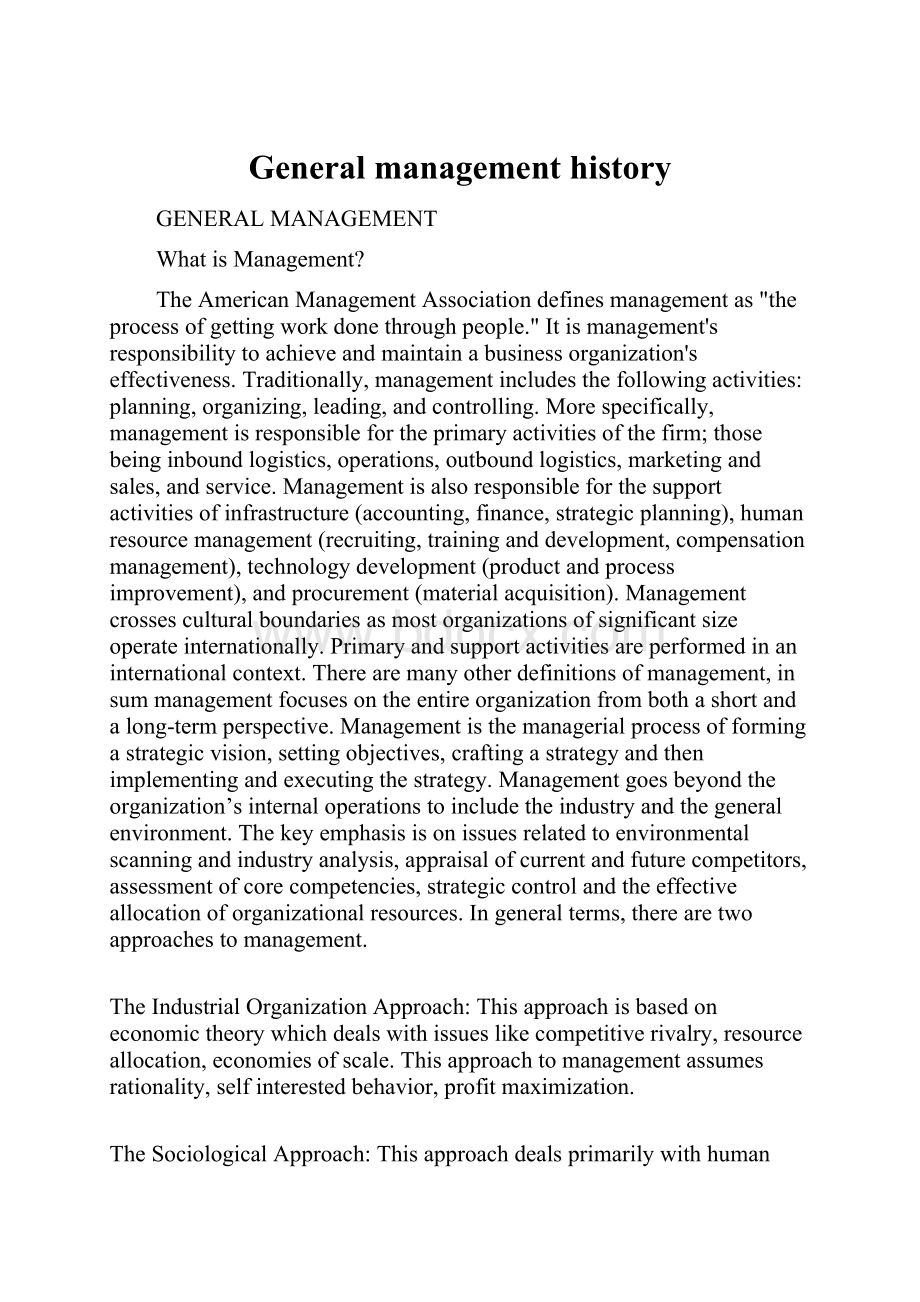 General management history.docx
General management history.docx
- 文档编号:26014058
- 上传时间:2023-06-17
- 格式:DOCX
- 页数:15
- 大小:25.90KB
General management history.docx
《General management history.docx》由会员分享,可在线阅读,更多相关《General management history.docx(15页珍藏版)》请在冰豆网上搜索。

Generalmanagementhistory
GENERALMANAGEMENT
WhatisManagement?
TheAmericanManagementAssociationdefinesmanagementas"theprocessofgettingworkdonethroughpeople."Itismanagement'sresponsibilitytoachieveandmaintainabusinessorganization'seffectiveness.Traditionally,managementincludesthefollowingactivities:
planning,organizing,leading,andcontrolling.Morespecifically,managementisresponsiblefortheprimaryactivitiesofthefirm;thosebeinginboundlogistics,operations,outboundlogistics,marketingandsales,andservice.Managementisalsoresponsibleforthesupportactivitiesofinfrastructure(accounting,finance,strategicplanning),humanresourcemanagement(recruiting,traininganddevelopment,compensationmanagement),technologydevelopment(productandprocessimprovement),andprocurement(materialacquisition).Managementcrossesculturalboundariesasmostorganizationsofsignificantsizeoperateinternationally.Primaryandsupportactivitiesareperformedinaninternationalcontext.Therearemanyotherdefinitionsofmanagement,insummanagementfocusesontheentireorganizationfrombothashortandalong-termperspective.Managementisthemanagerialprocessofformingastrategicvision,settingobjectives,craftingastrategyandthenimplementingandexecutingthestrategy.Managementgoesbeyondtheorganization’sinternaloperationstoincludetheindustryandthegeneralenvironment.Thekeyemphasisisonissuesrelatedtoenvironmentalscanningandindustryanalysis,appraisalofcurrentandfuturecompetitors,assessmentofcorecompetencies,strategiccontrolandtheeffectiveallocationoforganizationalresources.Ingeneralterms,therearetwoapproachestomanagement.
TheIndustrialOrganizationApproach:
Thisapproachisbasedoneconomictheorywhichdealswithissueslikecompetitiverivalry,resourceallocation,economiesofscale.Thisapproachtomanagementassumesrationality,selfinterestedbehavior,profitmaximization.
TheSociologicalApproach:
Thisapproachdealsprimarilywithhumaninteractions.Itassumesrationality,satisfyingbehavior,profitsub-optimality.
Managementtheoriescanalsobedividedintotwosets.Oneisthesetthatconcentratesmainlyonefficiencyandanotheristhesetthatconcentratesmainlyoneffectiveness.Efficiencyisaboutdoingthingstherightway.Itinvolveseliminatingwasteandoptimizingprocesses.Effectivenessisaboutdoingtherightthings.Agoodmanagementstyleisablendofbothefficiencyandeffectiveness.Thereisnopointinactingefficientlyifwhatyouaredoingwillnothavethedesiredeffect.Managementtechniquescanbeviewedaseitherbottom-up,top-down,orcollaborativeprocesses.InmanycountriessuchasEuropeandtheEasterncountriesthetopdownapproachispopular.IntheU.S.Managementispracticedinmanydifferentways.Inthetop-downapproach,themanagementmakesthedecisions,whichtheemployeeshavenochoicebuttoaccept.Ontheotherhand,inthebottom-upapproach,employeessubmitproposalstotheirmanagerswho,inturn,funnelthebestideasfurtheruptheorganization.Thebottomupapproachisnotpopularforfamilyrunbusinesses.
Whatismanagementscience?
TheJudgeBusinessSchoolattheUniversityofCambridge,UK,definesManagementScienceasfollows:
ManagementScienceisaninterdisciplinaryfieldthatappliesmathematics,statistics,computerscienceandeconomicstoproblemsandissuesofmanagementinboththeprivateandpublicsectorsandacrossallbusinessfunctions,fromoperationstofinanceandfrommarketingtostrategy.Mathematicalmodelsareusedtodevelopanunderstandingofthe"physics"ofasituation(e.g.theflowofreal,physicalobjectssuchasmaterialsandtheobservableactionsofpeople)andtoconnectthephysicstotheeconomics(e.g.financialflowsorsocialcostsandbenefits).ManagementScience,asabodyofknowledge,focusesonquantifiablevariables;keyconceptsincludechange,uncertainty,optimalityandefficiency.Weaimtounderstandmanagementproblemsandmanagementsystemsinthesamewayasphysicistsandengineersunderstandtheirsystems:
bydecomposingthemintosuitableparts,studyingtheparts,possiblysub-dividingagain,andthenstudyinghowthesepartsarecombinedandintegratedtoproducethefunctionoftheoverallsystem.Modelingisourcoremethodology.Ourcredois"wedonotunderstandwhatwecannotmodel."Notallmanagementproblemsareamenabletoa"ManagementSciencetreatment"-butmanyare.Thedecompositionapproachofengineeringoffersageneralroadmaptounderstandingamanagementproblemorsystemandimprovingit.
Akeydifferencebetween"real"scienceandManagementScienceisthatmanagementproblemsdon'thaveanatural"rightanswer".Mostmanagementproblemsaresignificantlymorecomplexandmessythantraditionalscientificproblems.Theyincludehumaninteractionsandtakeplaceinpoliticalenvironments,whicharenotgovernedbysimplerulesthatcanbeformulatedinatractablemathematicalorcomputationalmodel.Evenifwecandeviseamodelthatwebelievereflectsareal-lifemanagementsituationquitewell,thereisoftenalackofreliabledatatofeedintothemodelandcalibrateittothepracticalsituation.Wemustalwaysbeawareoftheseinherentlimitationsofourdiscipline.Inthatregard,thetermManagementScienceisamisnomer.Infact,thedisciplineismuchlessambitiousandmuchmorepragmatic:
Theremaynotbearightanswerbuttherearemoresensibleandlesssensibleanswers,thereareanswersthatworkbetteroraremoreconvincingthanothers.Anddataandmodelscanhelpusdistinguishthegoodfromthebad.ThisistheplaygroundofManagementScienceanditisthispragmatic"whatcountsiswhatworks"attitudethatthedisciplineshareswiththeengineeringfield
(1).
Historyofmanagement
Forustounderstandwhattheorywecanapplytoday,wemustknowwhathasbeendoneinthepast;whatweshouldcapitalizeonandwhatweshouldnotrepeat.Thehistoryofmanagementleadsustounderstandthecomplexityofthe
topicandthechallengescontemporaryleadersfacetoday.Modernmanagementwouldnotbeapplicableifpreviousmanagementtheoriesarenotstudied.
ClassicalSchool
TheClassicalschoolofthoughtbeganaround1900andcontinuedintothe1920s.Traditionalorclassicalmanagementfocusesonefficiencyandincludesbureaucratic,scientificandadministrativemanagement.Bureaucraticmanagementreliesonarationalsetofstructuringguidelines,suchasrulesandprocedures,hierarchy,andacleardivisionoflabor.Scientificmanagementfocusesonthe"onebestway"todoajob.Administrativemanagementemphasizestheflowofinformationintheoperationoftheorganization.
Bureaucracy
MaxWeber(1864-1920),knownastheFatherofModernSociology,analyzedbureaucracyasthemostlogicalandrationalstructureforlargeorganizations.Bureaucraciesarefoundedonlegalorrationalauthoritywhichisbasedonlaw,procedures,rules,andsoon.Positionalauthorityofasuperioroverasubordinatestemsfromlegalauthority.Charismaticauthoritystemsfromthepersonalqualitiesofanindividual.Efficiencyinbureaucraciescomesfrom:
(1.)clearlydefinedandspecializedfunctions;(2.)useoflegalauthority;(3.)hierarchicalform;(4.)writtenrulesandprocedures;(5.)technicallytrainedbureaucrats;(6.)appointmenttopositionsbasedontechnicalexpertise;(7.)promotionsbasedoncompetence;(8.)clearlydefinedcareerpaths.
ScientificManagement
Scientificmanagementfocusesonworkerandmachinerelationships.Organizationalproductivitycanbeincreasedbyincreasingtheefficiencyofproductionprocesses.Theefficiencyperspectiveisconcernedwithcreatingjobsthateconomizeontime,humanenergy,andotherproductiveresources.Jobsaredesignedsothateachworkerhasaspecified,wellcontrolledtaskthatcanbeperformedasinstructed.Specificproceduresandmethodsforeachjobmustbefollowedwithnoexceptions.
FrederickTaylor(1856-1915)
ManyofFrederickTaylor'sdefinitivestudieswereperformedatBethlehemSteelCompanyinPittsburgh.Toimproveproductivity,Taylorexaminedthetimeandmotiondetailsofajob,developedabettermethodforperformingthatjob,andtrainedtheworker.Furthermore,Taylorofferedapieceratethatincreasedasworkersproducedmore.In1911,FrederickTaylor,knownastheFatherofScientificManagement,publishedPrinciplesofScientificManagementinwhichheproposedworkmethodsdesignedtoincreaseworkerproductivity.Oneofhisfamousexperimentshadtodowithincreasingtheoutputofaworkerloadingpigirontoarailcar.Taylorbrokethejobdownintoitssmallestconstituentmovements,timingeachonewithastopwatch.Thejobwasredesignedwithareducednumberofmotionsaswellaseffortandtheriskoferror.Restperiodsofspecificintervalanddurationandadifferentialpayscalewereusedtoimprovetheoutput.Withscientificmanagement,Taylorincreasedtheworker'soutputfrom12to47tonsperday!
TheTaylormodelgaverisetodramaticproductivityincreases.
Frank(1868-1924)andLillian(1878-1972)Gilbreth
FrankandLillianGilbrethemphasizedmethodbyfocusingonidentifyingtheelementalmotionsinwork,thewaythesemotionswerecombinedtoformmethodsofoperation,andthebasictimeeachmotiontook.Theybelieveditwaspossibletodesignworkmethodswhosetimescouldbeestimatedinadvance,ratherthanrelyinguponobservation-basedtimestudies.FrankGilbreth,knownastheFatherofTimeandMotionStudies,filmedindividualphysicallabormovements.Thisenabledthemanagertobreakdownajobintoitscomponentpartsandstreamlinetheprocess.H
- 配套讲稿:
如PPT文件的首页显示word图标,表示该PPT已包含配套word讲稿。双击word图标可打开word文档。
- 特殊限制:
部分文档作品中含有的国旗、国徽等图片,仅作为作品整体效果示例展示,禁止商用。设计者仅对作品中独创性部分享有著作权。
- 关 键 词:
- General management history
 冰豆网所有资源均是用户自行上传分享,仅供网友学习交流,未经上传用户书面授权,请勿作他用。
冰豆网所有资源均是用户自行上传分享,仅供网友学习交流,未经上传用户书面授权,请勿作他用。


 《爱和自由》读书心得15篇.docx
《爱和自由》读书心得15篇.docx
